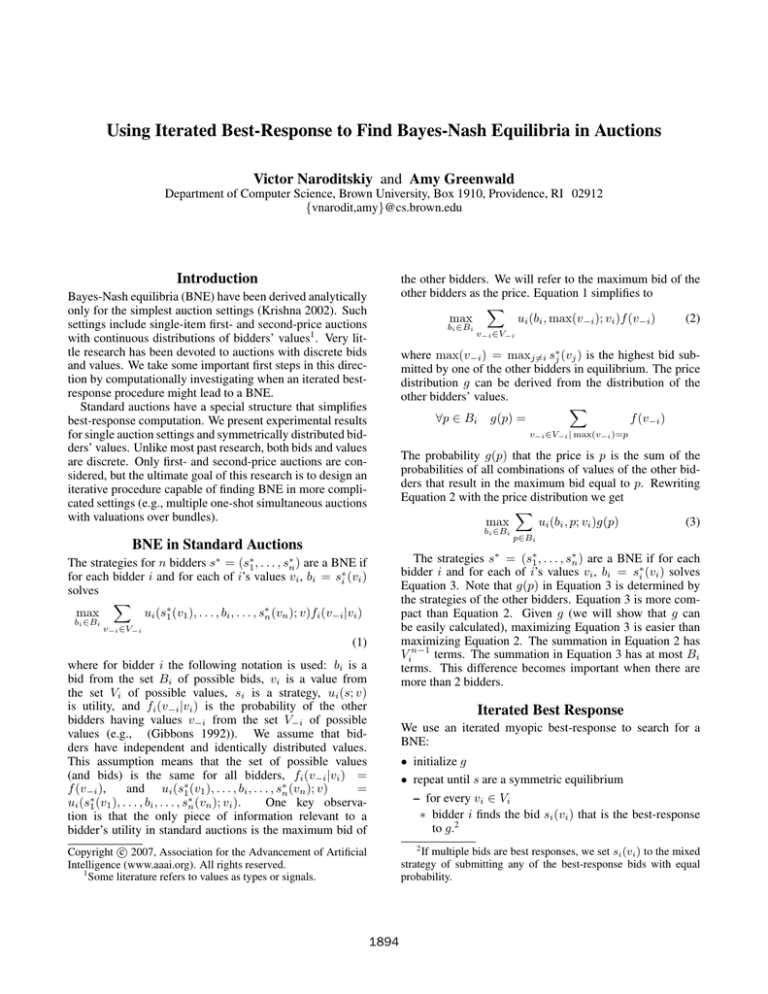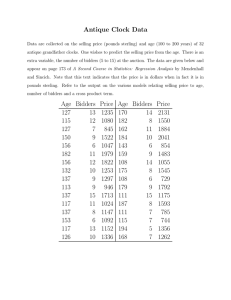Using Iterated Best-Response to Find Bayes-Nash Equilibria in Auctions Introduction
advertisement

Using Iterated Best-Response to Find Bayes-Nash Equilibria in Auctions
Victor Naroditskiy and Amy Greenwald
Department of Computer Science, Brown University, Box 1910, Providence, RI 02912
{vnarodit,amy}@cs.brown.edu
Introduction
the other bidders. We will refer to the maximum bid of the
other bidders as the price. Equation 1 simplifies to
ui (bi , max(v−i ); vi )f (v−i )
(2)
max
Bayes-Nash equilibria (BNE) have been derived analytically
only for the simplest auction settings (Krishna 2002). Such
settings include single-item first- and second-price auctions
with continuous distributions of bidders’ values1 . Very little research has been devoted to auctions with discrete bids
and values. We take some important first steps in this direction by computationally investigating when an iterated bestresponse procedure might lead to a BNE.
Standard auctions have a special structure that simplifies
best-response computation. We present experimental results
for single auction settings and symmetrically distributed bidders’ values. Unlike most past research, both bids and values
are discrete. Only first- and second-price auctions are considered, but the ultimate goal of this research is to design an
iterative procedure capable of finding BNE in more complicated settings (e.g., multiple one-shot simultaneous auctions
with valuations over bundles).
bi ∈Bi
v−i ∈V−i
where max(v−i ) = maxj=i s∗j (vj ) is the highest bid submitted by one of the other bidders in equilibrium. The price
distribution g can be derived from the distribution of the
other bidders’ values.
f (v−i )
∀p ∈ Bi g(p) =
v−i ∈V−i | max(v−i )=p
The probability g(p) that the price is p is the sum of the
probabilities of all combinations of values of the other bidders that result in the maximum bid equal to p. Rewriting
Equation 2 with the price distribution we get
ui (bi , p; vi )g(p)
(3)
max
bi ∈Bi
BNE in Standard Auctions
The strategies s∗ = (s∗1 , . . . , s∗n ) are a BNE if for each
bidder i and for each of i’s values vi , bi = s∗i (vi ) solves
Equation 3. Note that g(p) in Equation 3 is determined by
the strategies of the other bidders. Equation 3 is more compact than Equation 2. Given g (we will show that g can
be easily calculated), maximizing Equation 3 is easier than
maximizing Equation 2. The summation in Equation 2 has
Vin−1 terms. The summation in Equation 3 has at most Bi
terms. This difference becomes important when there are
more than 2 bidders.
The strategies for n bidders s∗ = (s∗1 , . . . , s∗n ) are a BNE if
for each bidder i and for each of i’s values vi , bi = s∗i (vi )
solves
ui (s∗1 (v1 ), . . . , bi , . . . , s∗n (vn ); v)fi (v−i |vi )
max
bi ∈Bi
p∈Bi
v−i ∈V−i
(1)
where for bidder i the following notation is used: bi is a
bid from the set Bi of possible bids, vi is a value from
the set Vi of possible values, si is a strategy, ui (s; v)
is utility, and fi (v−i |vi ) is the probability of the other
bidders having values v−i from the set V−i of possible
values (e.g., (Gibbons 1992)). We assume that bidders have independent and identically distributed values.
This assumption means that the set of possible values
(and bids) is the same for all bidders, fi (v−i |vi ) =
and ui (s∗1 (v1 ), . . . , bi , . . . , s∗n (vn ); v)
=
f (v−i ),
One key observaui (s∗1 (v1 ), . . . , bi , . . . , s∗n (vn ); vi ).
tion is that the only piece of information relevant to a
bidder’s utility in standard auctions is the maximum bid of
Iterated Best Response
We use an iterated myopic best-response to search for a
BNE:
• initialize g
• repeat until s are a symmetric equilibrium
– for every vi ∈ Vi
∗ bidder i finds the bid si (vi ) that is the best-response
to g.2
If multiple bids are best responses, we set si (vi ) to the mixed
strategy of submitting any of the best-response bids with equal
probability.
c 2007, Association for the Advancement of Artificial
Copyright Intelligence (www.aaai.org). All rights reserved.
1
Some literature refers to values as types or signals.
2
1894
– h is a frequency distribution of bids si
– H is the corresponding cumulative distribution
– g(p) = H n−1 (p) − H n−1 (p − 1)
strategies for the continuous case. The continuous counter1
parts for these discrete strategies are to bid 10
11 and 2 of the
value respectively.
The strategies s = (s1 , . . . , sn ) are a symmetric BNE if
si is a best response to the price distribution resulting from
n − 1 bidders playing si . We check this condition at the start
of the loop.
In each iteration we calculate bidder i’s best response si
to the price distribution g. The best response is calculated
for each value vi ∈ Vi . At the end of an iteration, g is set
to the price distribution resulting from n − 1 bidders playing si . This price distribution is calculated using the cumulative distribution H of bids submitted by bidder i. The
cumulative distribution of the maximum of n − 1 bids distributed according to H is H n−1 . For integer prices p the
probability density function g(p) can be calculated from H:
g(p) = H n−1 (p) − H n−1 (p − 1).
We assume that bidders’ values are symmetrically distributed. Therefore all bidders have the same best-response
strategy si and we only need to find the best-response of one
bidder (bidder i).
The iterated best-response procedure is inspired by a procedure for finding self-confirming price distributions (Osepayshvili et al. 2005).
k
8
7
# bidders
11
2
equilibrium strategy
0:0,1:0,2:1,3:2,4:3,5:4,6:5,7:6,8:7
0:0,1:0,2:1,3:1,4:2,5:2,6:3,7:3
Table 1: Equilibria in First-Price Auctions. 3:1, 4:2,... denotes the strategy of bidding 1 when the value is 3 and bidding 2 when the value is 4.
Related and Future Work
The procedure described here coincides with Cournot adjustment (e.g. (Fudenberg & Levine 1998)) when each bidder’s set of values contains only one element.
(Reeves & Wellman 2004) describe a procedure for
computing best-response strategies and finding Bayes-Nash
equilibrium for two-player infinite games with types drawn
from a piecewise-uniform distribution.
This paper is a preliminary study of discrete auctions. In
future work we are going to search for iterative procedures
with better convergence properties. Pure strategy BNE does
not always exist. We are also interested in procedures capable of finding mixed Bayes-Nash equilibria.
The procedure discussed in this paper can be extended
to multiple one-shot simultaneous auctions with valuations
over bundles. In the multi-auction setting, the strategies of
bidders are vectors of bids for all auctions and the probability distribution is over vectors of prices in all auctions.
Experiments
We test the procedure in first- and second-price auctions.
The number of bidders ranges between 2 and 11. Bidders
have integer values uniformly distributed between 0 and k.
The parameter k ranges from 2 to 50. Given a value v and a
price distribution, an optimal bid is calculated by comparing
profits from bidding each of the v + 1 bids 0, 1, . . . , v. If
the bid is equal to the price, the bidder wins the object with
probability n1 . The bidder pays his bid in the first-price auction and the price in the second-price auction. We tried two
ways of initializing the price distribution: to zero and to the
value distribution.
References
Fudenberg, D., and Levine, D. K. 1998. The Theory of
Learning in Games. MIT Press.
Gibbons, R. 1992. Game Theory for Applied Economists.
Princeton University Press.
Krishna, V. 2002. Auction Theory. Academic Press.
Osepayshvili, A.; Wellman, M.; Reeves, D.; and MacKieMason, J. 2005. Self-confirming price prediction for bidding in simultaneous ascending auctions. In Computing
and Markets.
Reeves, D. M., and Wellman, M. P. 2004. Computing
best-response strategies in infinite games of incomplete information. In UAI.
Second-Price Auctions
The second-price auction has a known dominant strategy of
bidding the true value. The iterative procedure converges
to the dominant strategy after 2 iterations when the price
distribution is initialized to zero and after 1 iteration when
the price distribution is initialized to the value distribution.
First-Price Auctions
The procedure converges to an equilibrium in most of our
experiments with varying number of bidders and initial price
distributions for values of k below 9. It takes under 8 iterations (usually 1 iteration) to reach convergence when the
price distribution is initialized to the value distribution. It
takes under 27 iterations (5 iterations on average) to reach
convergence when the price distribution is initialized to zero.
Examples of equilibria are in Table 1.
Bidding n−1
n of the value is a BNE of a first-price auction
when bidders’ values are identically distributed according to
a continuous uniform distribution (Krishna 2002). The equilibrium strategies in Table 1 are similar to the equilibrium
1895

